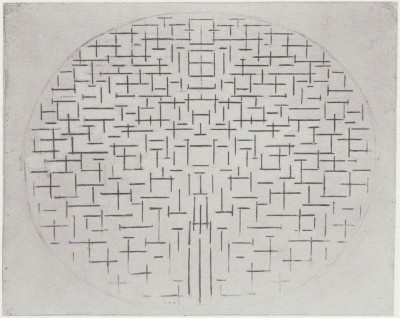Zhu Derun on Primordial Chaos
November 30th, 2007
A 1349 painting by Zhu Derun, reproduced in Three Thousand Years of Chinese Painting.
Hunlu tu [Primordial Chaos], handscroll, ink on paper, p163. Click image for larger version.
James Cahill describes the painting: “Hunlun refers to the great undifferentiated matter out of which the cosmos was formed, and the philosophical intent of the work is stated in Zhu’s inscription, which takes the form of a brief essay on this Daoist cosmological concept. Hunlun, he writes, is not square but round, not round but square. Before the appearance of heaven and earth there were no forms, and yet forms existed; after the appearance of heaven and earth forms existed, but their constant expansion and contraction, or unfurling and furling, makes them beyond measuring.
“The work, in keeping with this theme, is part picture, part cosmic diagram. The objects in it represent, among other things, states of transformation, or rates of growth and decay: very slow in the earth and rock, somewhat faster in the pine, faster still in the wind-blown, ‘unfurling’ vines. One might be tempted to read the circle at the right as another symbol of change, the inconstant moon, or its reflection in the water, but it is too large and too abstract to encourage that reading and must in some way represent the circular hunlun itself… The drawing of the swirling vines seems also to have loosened itself from representation and entered the realm of the abstract and diagrammatic. One could also see Zhu Derun’s rendering of the bank, rock, pine, and grasses as similarly driven more by brush momentum than by attention to forms” (p163).
Cartoon as Vacuum
November 25th, 2007
Nine panels from Scott McCloud’s comic book on comic books, Understanding Comics.
On the universality of a cartoon face (p31):


And thus our universal identification (p36):

A diagram of the pictorial vocabulary of comics, from reality & resemblance to language, meaning, & iconicity, and their representation on the picture plane, as ink on paper (p51):
Click image for larger version.
On our emotional response to line (p119):

Polygonal Numbers and Pie
November 21st, 2007
Four mathematical illustrations from Wells’ Dictionary of Curious and Interesting Numbers.
“The maximum number of pieces into which a pancake [or pie] can be cut with 6 slices” is 22 (p78):

22 is also the 4th pentagonal number — whereas “the 4th centered hexagonal number, obtained by arranging hexagonal layers around a central point,” is 37 (p99):

“By a different division [of the above] the nth centered hexagonal number is equal to 6Tn-1 + 1, where Tn is the nth triangular number” (p100). Here we see a composition using the 3rd triangular number:

And the 4th triangular number? — 10, the tetractys, a figuration “so holy [to the Pythagoreans] that they even swore oaths by it” (p61, c.f. the obverse seal):

The Vertical Line in Angular Composition
November 13th, 2007
Two paintings analyzed by Henry Rankin Poore in his 1967 Pictorial Composition.
“The vertical line is much more important than any other. In nature, it is the direction of gravity. It distinguishes upright man from the lower animals. It also can stand alone, while all other lines demand supports. Of two lines of equal force the vertical is the one first seen. In composition, therefore, it takes precedence.
“Start with a subject represented by a vertical line — a tree or figure. The directness, rigidity, isolation and unqualified force of such a line demands balance. If you visualize a frame or put sides on the picture, you will see why a horizontal line bisecting the vertical becomes necessary. Length and breadth must be represented, something in two dimensions started, and so the four sides of a frame are essential” (p59-60).

‘Approach to Venice’ by Joseph Mallord William Turner.
“When Giotto was asked for his conception of a perfect building, he produced a circle. When Michelangelo was asked, he designated a cross. Both are excellent bases for good architecture and good pictures. If the extremities of the Greek cross are connected by arcs, a circle will result. If the Latin cross is bounded in the same way, a kite shape, or ellipse, emerges. The two designs are in a sense similar. From the pictorial standpoint, they provide the framework by which the same space can be filled” (p58).
“The simple vertical line is monotonous. Its bi-section produces balance — and a cross is the result” (p58).

‘Pier and Ocean’ by Piet Mondrian.
Bothwell’s Notan
November 10th, 2007
Three examples of notan from Dorr Bothwell‘s Notan: The Dark-Light Principle of Design.

First, perceive the black shapes above as weights. Allow your attention to shift from one weight to another.
“Now consider the black shapes no longer as weights or things, but as HOLES — or NO-THINGS. You might imagine, for instance, that you are looking at a piece of solid white wood full of empty black holes. This visual exchange — the perception of a shift from things to no-things, from no-things to things — is characteristic of Notan” (p21).
Finally, perceive the composition as “a representation no longer of HOLES but of BLACK ROCKS in WHITE WATER. If and when this representation is realized, both the negative and positive spaces will no longer alternate in their existence, but will interact in an interchangeable balance. The rocks and water will become equally important, equally real. This is the creation of Notan” (p21-22).

Clay dish. Pueblo Indian work, Acoma, New Mexico.
“Working within the confines of the shape of the plate, [the Pueblo Indian craftsman] succeeded in designing a bird that would become an inseparable part of the whole or a design in which the spaces around the bird would assume a form with an exchange of positive and negative… And when this is discovered, the negative space will no longer be ’empty’, but, instead, there will be Notan” (p8).

“A variation of the Yang-Yin symbolizing the horizon with the sun rising and setting” (p7).

